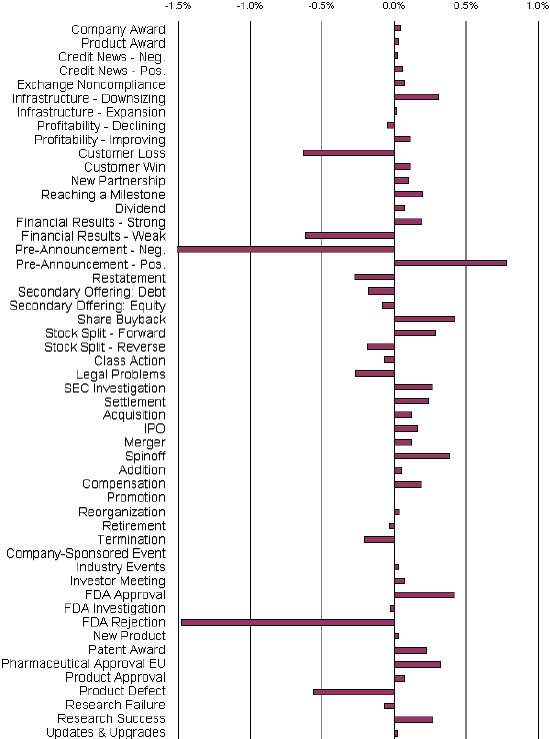What types of corporate news have the most impact on stock price? In their February 2010 paper entitled “Market Reaction to Corporate News and the Influence of the Financial Crisis”, Andreas Neuhierl, Anna Scherbina and Bernd Schlusche analyze immediate stock return, volatility and liquidity reactions to various types of corporate news (focusing on one day before to five days after release date). They segment news releases into nine major categories and 52 subcategories. Using a comprehensive sample of 285,917 corporate press releases carried by all major news wire services between April 2006 and August 2009, they find that:
- Investors respond strongly to news about financial performance, strategy, customers and partners, products and services, management changes and legal developments.
- Response is most positive on average for announcements of: (1) preliminary (before scheduled reporting date) positive financial results; (2) share buybacks; (3) FDA approvals; (4) spin-offs; and, (5) pharmaceutical approvals in the European Union.
- Response is most negative on average for announcements of: (1) preliminary (before scheduled reporting date) negative financial results; (2) FDA rejections; (3) loss of a customer; (4) poor financial results (on scheduled release date); and, (5) product defect announcements.
- Return volatility increases and liquidity decreases following most news announcements.
- Idiosyncratic volatility increases the most on average after announcements of: (1) preliminary (before scheduled reporting date) negative financial results; (2) SEC investigations; (3) management compensation; (4) reverse stock splits; and, (5) FDA rejections.
- Liquidity decreases the most on average after announcements of: (1) investor meetings; (2) reverse stock splits; (3) preliminary (before scheduled reporting date) negative financial results; (4) FDA rejections; and, (5) SEC investigations.
- Response to bad news is more likely to anticipate announcement dates (perhaps due to leaks), and negative price reaction tends to be bigger than positive price reaction.
- Most price responses appear to persist for at least one month after announcement.
- Responses to some news categories change during the 2008 financial crisis.
- Response to positive announcements about future cash flows (corporate reorganization, new customers and partners, new products, FDA and European drug approvals and legal settlements) tends to be more strongly positive.
- Response to announcements of equity/debt offerings tends to be less negative, and response to announcements of share repurchases tends to be even more positive.
The following chart, taken from the paper, compares mean cumulative abnormal returns for various categories of news from one day before (in case news has leaked) to five days after announcement date. The short event window focuses on immediate news impact and minimizes the chance of confounding announcements. The news categories that tend to produce the most negative price reactions are Pre-Anouncement – Neg., FDA Rejection, Customer Loss, Financial Results – Weak and Product Defect. Those that tend to produce the most positive price reactions are Pre-Announcement – Pos., Share Buyback, FDA Approval, Spin-off and Pharmaceutical Approval – EU.

In summary, evidence indicates that stock prices react somewhat predictably in direction and magnitude to specific categories of news, but general market conditions may affect the reactions.